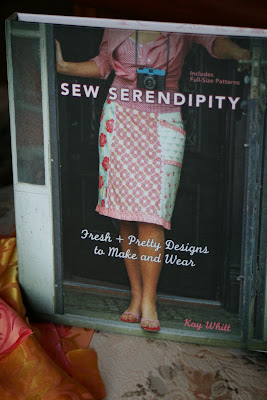 I realize this is a less-than-chic look, but at the time I didn't care. I wanted something quick and I wanted it simple. Nothing simpler than a gathered skirt - I didn't even use a pattern. I cut two rectangles, 40 inches wide by 29 inches long, for the body of the skirt, and I cut another rectangle, about 5 1/4 inches wide, for the waistband. I made the waist 29 1/2 inches long and I think that has made the skirt a little too big in the waist. I need to make it a little tighter in the future. I put in a four inch hem to give the hem weight. I used a red zipper because that is what I had on hand, so I used a red button, too:
I realize this is a less-than-chic look, but at the time I didn't care. I wanted something quick and I wanted it simple. Nothing simpler than a gathered skirt - I didn't even use a pattern. I cut two rectangles, 40 inches wide by 29 inches long, for the body of the skirt, and I cut another rectangle, about 5 1/4 inches wide, for the waistband. I made the waist 29 1/2 inches long and I think that has made the skirt a little too big in the waist. I need to make it a little tighter in the future. I put in a four inch hem to give the hem weight. I used a red zipper because that is what I had on hand, so I used a red button, too: This fabric is from my stash, and I bought it at The Fabric Place in Massachuestts about six years ago. It was on the wool table, but I am pretty sure it is 100% polyester - I could tell by the odor when I ironed it with steam. No burn test necessary - there is no more distinctive smell than polyester when it is ironed!
This fabric is from my stash, and I bought it at The Fabric Place in Massachuestts about six years ago. It was on the wool table, but I am pretty sure it is 100% polyester - I could tell by the odor when I ironed it with steam. No burn test necessary - there is no more distinctive smell than polyester when it is ironed!Fortunately, it wasn't bad to work with, and it doesn't wrinkle. It got the job done for a quick project, just to satisfy my sewing soul. If I make this skirt again, I will shorten it by 2 inches for a less dowdy look, and to make it (hopefully) more vaguely rockin'.
This afternoon I wandered into the sewing studio (a/k/a the entire downstairs of my house) and I wanted to do something, but not take on a big project. So I made a muslin (gasp!) of a strapless bodice from a vintage pattern just to see how it would fit me (size 14, bust 34). Here is the front:
 Here is the back:
Here is the back: And here are the front and back pattern pieces:
And here are the front and back pattern pieces: The bust fits fine, but the waist and hip area is a tad tight. I think I need to add an extra 1/2 inch in the waist/hip area to make it fit better. Here's my question: should alter the pattern at the side seams, or should I narrow the darts to add the extra 1/2 inch? Does it matter? I'm leaning towards making the darts narrower, but I don't know the "correct" way to make this alteration. Any feedback would be greatly appreciated!
The bust fits fine, but the waist and hip area is a tad tight. I think I need to add an extra 1/2 inch in the waist/hip area to make it fit better. Here's my question: should alter the pattern at the side seams, or should I narrow the darts to add the extra 1/2 inch? Does it matter? I'm leaning towards making the darts narrower, but I don't know the "correct" way to make this alteration. Any feedback would be greatly appreciated!Parting Shot: For Thanksgiving, the Carpenter and I went to Williamsburg, VA. My favorite photo I took all day at historic Williamsburg - he was squirrel hunting:














































